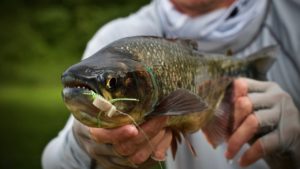
Tico is the affectionate term that native Costa Ricans call those who were born in their country, a country so beautiful, diverse and varied, yet so completely approachable and navigable. When people talk about fishing in Costa Rica, their minds immediately conjure up images of jumping tarpon and sailfish busting through the ocean surface. Without a doubt, this is there for the taking. But many Ticos spend their time fishing for other species that are fresh water inhabitants. In fact, the country is home to an abundancy of cold-water streams and warm rivers that are exquisitely beautiful and home to a multitude of fish species that pair perfectly with the tenkara fly fishing method. While tarpon and sailfish are Costa Rican mainstays, trout, machaca and other species are untapped fly fishing jackpots for this exotic tropical country.
 After more than a year of conversation with Tom Enderlin, owner of Release Fly Travel, a guide, outfitting and travel service in Costa Rica, we both decided we wanted to talk more about collaborating and exploring the unspoiled and untapped fly fishing opportunities in his country. What Tom described in his emails sounded like tenkara heaven and while he and his associates did have experience fishing tenkara, they focused on the very small, traditional aspects of the method. The idea of a machaca on tenkara intrigued us both and so, an 8-day trip was planned. We would scout water, experiment with tenkara rods and explore the different waters of the country. An itinerary was set, and this past February I finally got to meet Tom and his crew.
After more than a year of conversation with Tom Enderlin, owner of Release Fly Travel, a guide, outfitting and travel service in Costa Rica, we both decided we wanted to talk more about collaborating and exploring the unspoiled and untapped fly fishing opportunities in his country. What Tom described in his emails sounded like tenkara heaven and while he and his associates did have experience fishing tenkara, they focused on the very small, traditional aspects of the method. The idea of a machaca on tenkara intrigued us both and so, an 8-day trip was planned. We would scout water, experiment with tenkara rods and explore the different waters of the country. An itinerary was set, and this past February I finally got to meet Tom and his crew.
Since this relatively small country consists of such varied climatic regions, he proposed a scouting adventure to experience a broad taste of Costa Rica’s fresh water fisheries, an opportunity to revel in the country’s bio-diversity and time to explore what he and I suspected, to be perfect tenkara waters. Although weather and climate are consistently mild, with only a small flux in temperatures, there was a notable difference in each region we visited and fished. Warm, arid, rolling hills, chilly, high-mountain cloud forests and hot, humid beaches, Costa Rica has it all.
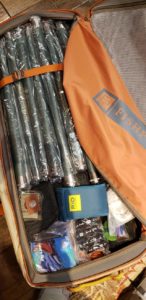
Preparing for the trip I made sure to bring all my different Zen rods since I wasn’t exactly sure what I was in for. Plus, Tom scheduled time for a little saltwater action on the last fishing day, so I packed lines of varying weight and lengths. Considering all I had, everything fit well into my Fishpond Grand Teton bag. This was my first time traveling to Costa Rica and I didn’t want any issues with TSA security and my carry-on. I decided to pack and check it all.
We arrived in San José mid-evening. Tom had arranged for us to be greeted and transported to our hotel in San José. It was in the heart of downtown and was wonderfully comfortable. We woke leisurely, ventured out for some Gallo Pinto (a traditional Costa Rican breakfast dish of rice and black beans served with natilla, which is similar to sour cream, and eggs), then spent the rest of the day exploring coffee plantations and a lush wildlife refuge, complete with rescued jaguars and invigorating, breathtaking waterfalls. All of this was arranged by Tom and I felt indulged since most of my fishing trips consist only of fishing. It was a relaxing day to acclimate, explore the city and take in some of the sights that are often bypassed when partaking in serious destination fly fishing trips. While Release Fly Travel has a dynamic tarpon conservation fishing program, a billfish school, and some other exciting programs around Latin America, this trip was about freshwater streams and rivers. Many species in Costa Rica are overlooked and don’t get much fanfare, but are fantastically appealing for fly fishing anglers, and particularly, tenkara anglers.
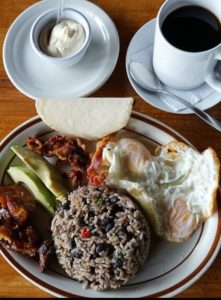 The next day we headed north to the Guanacaste Region, a few hours south of the Nicaragua border. In just a relatively short drive from San José, the lush greens hills just outside of the city, where coffee plants and strawberries thrive, gave way to tall, sparsely leafed trees, open fields and rice farms. The air was dry, warm and you could feel the heat of the sun. Howler monkeys bellowed loudly and made you think 200lb apes were hiding in the trees. On the river where we would fish, crocodiles lazily sunned on the shores and occasionally surfaced like a slow but stealthy submarine in the mist of often otherwise quiet water. The river flow was a moderate current that had sweet bubble lines and areas of small rapids, but the crocodiles never seemed to occupy these places – if they did, they went unseen.
The next day we headed north to the Guanacaste Region, a few hours south of the Nicaragua border. In just a relatively short drive from San José, the lush greens hills just outside of the city, where coffee plants and strawberries thrive, gave way to tall, sparsely leafed trees, open fields and rice farms. The air was dry, warm and you could feel the heat of the sun. Howler monkeys bellowed loudly and made you think 200lb apes were hiding in the trees. On the river where we would fish, crocodiles lazily sunned on the shores and occasionally surfaced like a slow but stealthy submarine in the mist of often otherwise quiet water. The river flow was a moderate current that had sweet bubble lines and areas of small rapids, but the crocodiles never seemed to occupy these places – if they did, they went unseen.
In this water, besides the crocodiles, several species of fish could be found, but we were here for the machaca. These cousins to piranha and pacu fight and behave in a manner that similar to tarpon and bass. They average a few pounds but can grow as big as 10lbs. Even more exciting are their teeth which are almost human-like, designed for crushing nuts and seeds that fall into the water from trees that line the river banks. Machaca also eat a variety of fruit and flowers. Depending on the season you either throw delicate “flower patterns” as you would throw a dry fly, or “poppers” to imitate the falling nuts as they hit the water with a loud “Plook,” which is exactly what we did. Green poppers the size of half a wine cork tied to represent the fruit of the wild cashew were slapped onto the water’s surface. We were instructed to count to 5, then pick it up and do it again – and again, and again, until our green cork morsel suddenly got ambushed by either a solo feeder who bolted in and out with incredible speed, or “wolf packs” of 4 to 6 machaca attracted by the loud “Plook,” and all savagely vying for the same cashew look-alike popper. “Plook!”
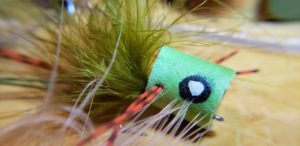
We typically used a size 1/0 hook and needed a relatively short cast, never more than 18ft total. Tom and his crew, Kevin Jackson, Chuta and Esteban Reyes all experimented with the rods and different line combinations. In certain areas there were overhanging branches and obstacles. A few tips were broken that morning learning how to deal with snags while on a rapidly moving float but by mid-morning we had it all figured out. When possible just retract the rod sections quickly until you can grab the line, then, yank hard. If you can’t get to the line fast enough, yell “Line!” to alert the other angler or rower on board to grab it. I’m a pro at collapsing quickly but it’s not a natural response for most anglers. The method works well, but in a worst-case scenario if you can’t collapse, it’s easier to let go of the rod. While this seems unorthodox, in most cases float boat rowers can usually maneuver the raft to the edge of the river and slowly work their way back to the spot. Tenkara rods float, so if the rod gets snagged in a tree, it isn’t going anywhere. Crazy, but the rod was always retrieved unbroken and ready for more fishing.
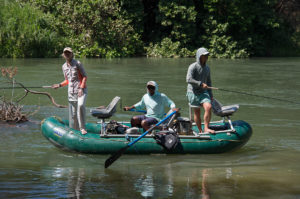 I will admit to one rod retrieval that I don’t think in good conscience I could recommend, but it did demonstrate the dedication of my Costa Rican, Release Fly Travel guides had, and their desire to keep an incredible day of fishing, incredible. On one particularly occasion, just at the top of some rapids, Tom snagged his fly good. This was before the lesson in rapid collapsing. The snag was in an overhanging tree branch and as we moved down stream, I urged him to let it go. The rod was simply suspended half in the water and half in the tree. Chuta, our rower and river guide quickly maneuvered the raft to the side of the river. Then by grabbing branches we worked our way upstream a little closer to the rod. Finally, Chuta jumped onto the bank, climbed the tree and slowly lowered himself down the branch to the snag releasing both Chuta and the rod into the water. WEARING his life jacket, he floated down to the raft and back to the bank, rod in hand, unbroken, fly intact. He is a Class 5 expert rafter and paddler. He accessed the situation and felt confident it was safe. I don’t think I would have done that, but I was grateful he did. (Do not try this method at home kids).
I will admit to one rod retrieval that I don’t think in good conscience I could recommend, but it did demonstrate the dedication of my Costa Rican, Release Fly Travel guides had, and their desire to keep an incredible day of fishing, incredible. On one particularly occasion, just at the top of some rapids, Tom snagged his fly good. This was before the lesson in rapid collapsing. The snag was in an overhanging tree branch and as we moved down stream, I urged him to let it go. The rod was simply suspended half in the water and half in the tree. Chuta, our rower and river guide quickly maneuvered the raft to the side of the river. Then by grabbing branches we worked our way upstream a little closer to the rod. Finally, Chuta jumped onto the bank, climbed the tree and slowly lowered himself down the branch to the snag releasing both Chuta and the rod into the water. WEARING his life jacket, he floated down to the raft and back to the bank, rod in hand, unbroken, fly intact. He is a Class 5 expert rafter and paddler. He accessed the situation and felt confident it was safe. I don’t think I would have done that, but I was grateful he did. (Do not try this method at home kids).
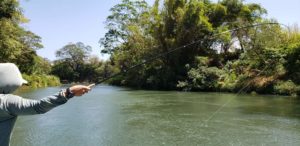 By day’s end we had mastered the rapid collapse, eliminated all snagging and came to a unanimous preference for the Zen Suimenka and Zako for their shorter lengths and overall 5wt/6wt FRAE Rating (Fly Rod Approximate Equivalency) that paired well with the machaca. We used 8-10ft of over-weighted regular level fly line and approximately 6-8ft of 20lb and 30lb tippet. We wanted a heavier line to load the rod and turn the tip over solid, in order to produce a good solid slap with the popper. This was by no means a delicate presentation. But it was fun and different. The rivers width changed here and there from about 20ft – 50ft across at its widest. Our rowers were experts at knowing where the machaca were and understood our fixed line limitation. They quickly homed in on the needed distance with precision, a skill essential on any tenkara float trip. While the wild cashew trees had not yet flowered, there seemed to be an anticipation of its delicacies beneath them and machaca hit the poppers ravenously, coming from seemingly nowhere.
By day’s end we had mastered the rapid collapse, eliminated all snagging and came to a unanimous preference for the Zen Suimenka and Zako for their shorter lengths and overall 5wt/6wt FRAE Rating (Fly Rod Approximate Equivalency) that paired well with the machaca. We used 8-10ft of over-weighted regular level fly line and approximately 6-8ft of 20lb and 30lb tippet. We wanted a heavier line to load the rod and turn the tip over solid, in order to produce a good solid slap with the popper. This was by no means a delicate presentation. But it was fun and different. The rivers width changed here and there from about 20ft – 50ft across at its widest. Our rowers were experts at knowing where the machaca were and understood our fixed line limitation. They quickly homed in on the needed distance with precision, a skill essential on any tenkara float trip. While the wild cashew trees had not yet flowered, there seemed to be an anticipation of its delicacies beneath them and machaca hit the poppers ravenously, coming from seemingly nowhere.
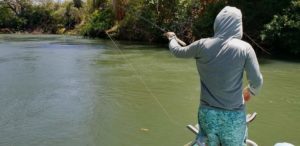 Once the hook was set it was all a matter of holding onto to them while navigating the river and occasional obstacles. Since lines were kept short, getting them to the float raft was relatively easy and in most cases the line was grabbed by the angler and self-landed. While this sounds simple enough, there was plenty of excitement. Machaca are strong fish and use their muscle to pull and dive. I got into a near record fish right at the beginning of the float that set the precedent and kept my heart pounding for a good 30 minutes after landing it. They are thick and rather primitive looking with all those teeth. Teeth that can easily rip through tippet during a fight, allowing them to get away. This is something to avoid by always keeping the line taught and staying in control of the fish’s head. Besides, leaving metal in fish mouths is never a good practice.
Once the hook was set it was all a matter of holding onto to them while navigating the river and occasional obstacles. Since lines were kept short, getting them to the float raft was relatively easy and in most cases the line was grabbed by the angler and self-landed. While this sounds simple enough, there was plenty of excitement. Machaca are strong fish and use their muscle to pull and dive. I got into a near record fish right at the beginning of the float that set the precedent and kept my heart pounding for a good 30 minutes after landing it. They are thick and rather primitive looking with all those teeth. Teeth that can easily rip through tippet during a fight, allowing them to get away. This is something to avoid by always keeping the line taught and staying in control of the fish’s head. Besides, leaving metal in fish mouths is never a good practice.
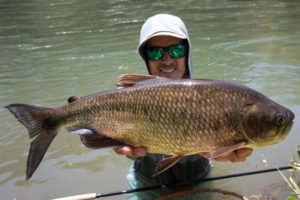 The second day in this northern region we did another float, but on a different river that had a series of Class 3 rapids. Just enough to get a little wet and add some extra fun and excitement to the float trip. We were targeting machaca again, but also hoping for guapote, otherwise known as rainbow bass. These beautiful fish are brilliant in color and fun to cast to since they hang out at the base of waterfalls flowing into the river. We rigged some rod setups with poppers for the machaca and others with buggers and streamers that were preferred by the guapote. There was also a possibility of snook. Crocodiles were less abundant since the river was much narrower here. Instead we traded them in for a different reptile, huge iguanas that scurried alongside the river’s steep edge and made rustling noises as they hid under bushes and brush, some as big as the smaller crocodiles. Vines hung down with random flowers that attracted birds of every color. Truly a magnificent day.
The second day in this northern region we did another float, but on a different river that had a series of Class 3 rapids. Just enough to get a little wet and add some extra fun and excitement to the float trip. We were targeting machaca again, but also hoping for guapote, otherwise known as rainbow bass. These beautiful fish are brilliant in color and fun to cast to since they hang out at the base of waterfalls flowing into the river. We rigged some rod setups with poppers for the machaca and others with buggers and streamers that were preferred by the guapote. There was also a possibility of snook. Crocodiles were less abundant since the river was much narrower here. Instead we traded them in for a different reptile, huge iguanas that scurried alongside the river’s steep edge and made rustling noises as they hid under bushes and brush, some as big as the smaller crocodiles. Vines hung down with random flowers that attracted birds of every color. Truly a magnificent day.
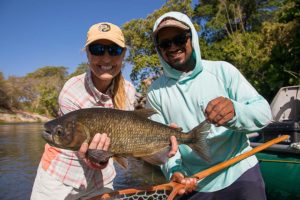
At the end of the day, back in our bungalow, I decided to cool off in the large swimming pool set in the middle of a green yard. As I swam and floated around listening to monkeys talk, monkey-talk, I was compelled to check the water for movement or a stray crocodile that decided swimming pool water was more refreshing. Like the music from JAWS that replayed in my head for years after watching that movie as a kid, I was now on hyper-alert for crocs – even though I know I was being silly.
On day 3 we packed our rods and headed to higher, cooler grounds in the cloud forest of the Talamanca mountain range. The roads were steep and winding, and the air was moist and cool. Driving along the two-lane Interamerican Highway we stopped at fresh fruit stands and got lunch. I dug out my pullover and puff jacket and slipped them on over my t-shirt. It felt cold. While 50 degrees is still mild, particularly if you live in Colorado, at a 10,000-12,000ft elevation, surrounded by clouds and moisture, the temperature felt quite chilly and I was relieved by the additional layers.
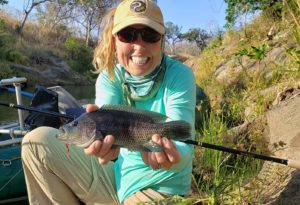 As we climbed higher the vegetation and trees changed again becoming more green, lush and shrouded by thick green vines. Bromeliads and other epiphytes were everywhere, and the surroundings looked dewy and moist. Cars moved along purposefully, and trucks strained to keep climbing. At the top, we turned off the main road and began heading down a short switchback into an even more lush area where we would eventually find our lodgings for the night and an excellent hot, home-cooked Costa Rican meal. We spent that evening sighting and watching birds, some rather rare, such as the resplendent quetzal, which some avid birders spend their lives trying to spot and get a glimpse of. We were lucky enough to not only see a quetzal, but we were indulged by having both a male and a female make a showing. That night as the temperature dropped, we each hunkered down in our own private tiny rustic cabin, high and deep in the cloud forested mountains and quickly fell asleep.
As we climbed higher the vegetation and trees changed again becoming more green, lush and shrouded by thick green vines. Bromeliads and other epiphytes were everywhere, and the surroundings looked dewy and moist. Cars moved along purposefully, and trucks strained to keep climbing. At the top, we turned off the main road and began heading down a short switchback into an even more lush area where we would eventually find our lodgings for the night and an excellent hot, home-cooked Costa Rican meal. We spent that evening sighting and watching birds, some rather rare, such as the resplendent quetzal, which some avid birders spend their lives trying to spot and get a glimpse of. We were lucky enough to not only see a quetzal, but we were indulged by having both a male and a female make a showing. That night as the temperature dropped, we each hunkered down in our own private tiny rustic cabin, high and deep in the cloud forested mountains and quickly fell asleep.
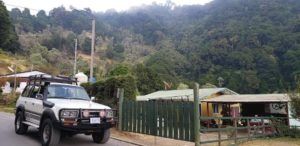 Awakened early by the morning songs of a plethora of birds, we hiked up the road back to the restaurant for a steamy breakfast, then collected our gear to explore the pristine river that lay ahead. Upon approaching it I paused and looked around, taking it all in. Beautiful tall trees (that would rarely cause a casting issue), a rough trail with easy access to the river’s edge, excellent water flow, boulders and rocks, plunge pools, bubble lines galore…this was tenkara nirvana. Just looking at it I could see this really was perfect tenkara water. I stepped closer and peered into the water. Fish, wild rainbow trout, alert, feeding, in abundance. I landed 4 with the first 7 casts. Tom knew what he was talking about.
Awakened early by the morning songs of a plethora of birds, we hiked up the road back to the restaurant for a steamy breakfast, then collected our gear to explore the pristine river that lay ahead. Upon approaching it I paused and looked around, taking it all in. Beautiful tall trees (that would rarely cause a casting issue), a rough trail with easy access to the river’s edge, excellent water flow, boulders and rocks, plunge pools, bubble lines galore…this was tenkara nirvana. Just looking at it I could see this really was perfect tenkara water. I stepped closer and peered into the water. Fish, wild rainbow trout, alert, feeding, in abundance. I landed 4 with the first 7 casts. Tom knew what he was talking about.
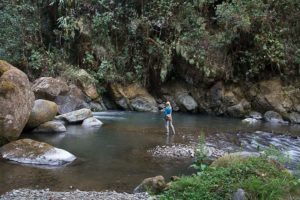 The day continued like this for the entire fishing party – all of us. Four anglers throwing different dry and nymph patterns, all day long, landing fish. While these were not large trout, what they lacked in size, they made up in beauty- the most vivid, robust colors. On average they were 6”-12” long and with colors so vibrant and intense, I had to exercise self-control in order not to hang onto them longer than I should, just admiring their beauty, but release them quickly back to their home. We all fished the Zen Suzume as it was, hands down, the perfect rod for this water with its three lengths (7.7’, 9.3’ and 10.8’). Paired with a 7ft Zen Floating Line and about 3 -4ft of 6x tippet, life and fishing was sweet.
The day continued like this for the entire fishing party – all of us. Four anglers throwing different dry and nymph patterns, all day long, landing fish. While these were not large trout, what they lacked in size, they made up in beauty- the most vivid, robust colors. On average they were 6”-12” long and with colors so vibrant and intense, I had to exercise self-control in order not to hang onto them longer than I should, just admiring their beauty, but release them quickly back to their home. We all fished the Zen Suzume as it was, hands down, the perfect rod for this water with its three lengths (7.7’, 9.3’ and 10.8’). Paired with a 7ft Zen Floating Line and about 3 -4ft of 6x tippet, life and fishing was sweet.
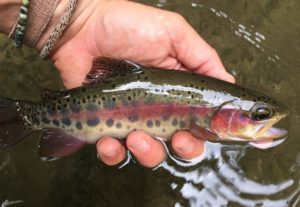 Tico trout, like most smaller trout are impressive fighters. They jump and dive and run with a fury, making the day spectacular in every way. In two days of exhilarating, fun fishing with a cloud forest as a backdrop, I was surprised we only passed a few birders from foreign countries looking for quetzals and other species I knew nothing about. Tom and Kevin on the other hand, could spot birds in tree tops and rattle off both their Latin and common name, while throwing in a few facts about each too. Half the time, even though he pointed and gave me precise location descriptions, I struggled to even notice them, let alone be able to identify them. They even identified birds by their songs. By the end of the trip I did get better at spotting birds, but couldn’t come close to noticing the minute, distinguishing details used for identifying the different species.
Tico trout, like most smaller trout are impressive fighters. They jump and dive and run with a fury, making the day spectacular in every way. In two days of exhilarating, fun fishing with a cloud forest as a backdrop, I was surprised we only passed a few birders from foreign countries looking for quetzals and other species I knew nothing about. Tom and Kevin on the other hand, could spot birds in tree tops and rattle off both their Latin and common name, while throwing in a few facts about each too. Half the time, even though he pointed and gave me precise location descriptions, I struggled to even notice them, let alone be able to identify them. They even identified birds by their songs. By the end of the trip I did get better at spotting birds, but couldn’t come close to noticing the minute, distinguishing details used for identifying the different species.
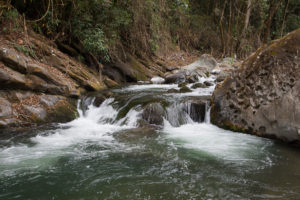 On the sixth day of our Costa Rican adventure, we drove back down to sea level from the mountains, ears popping, and found our way to the beach on the Pacific side. We settled into a lovely hotel and headed to the ocean to watch surfers and scrunch our toes in the hot sand. Kevin, who had been fishing with us all previous days and would eventually be heading up Release Fly Travel’s Tenkara Program, would be our saltwater, surfcasting guide tomorrow. We found a nice beach front watering hole and discussed the next day’s plan over Flor de Cana 12-year rum and fresh ceviche. A different heaven, but again, heaven.
On the sixth day of our Costa Rican adventure, we drove back down to sea level from the mountains, ears popping, and found our way to the beach on the Pacific side. We settled into a lovely hotel and headed to the ocean to watch surfers and scrunch our toes in the hot sand. Kevin, who had been fishing with us all previous days and would eventually be heading up Release Fly Travel’s Tenkara Program, would be our saltwater, surfcasting guide tomorrow. We found a nice beach front watering hole and discussed the next day’s plan over Flor de Cana 12-year rum and fresh ceviche. A different heaven, but again, heaven.
And on the seventh day, the last day of fishing in Costa Rica, we did not rest. Instead, we slathered ourselves with sunscreen, pulled on our Simms Saltwater Sneakers and loaded the Zen Kyojin II and Zen Taka Rods, along with our Winston Boron III Plus 8wt (just in case), saltwater fly boxes, and our spools of 20lb, 30lb, 40lb and 50lb Hatch Tippet and got in the car. Kevin had a sweet place in mind where he had lots of success surfcasting and would be reasonably accessible with the low tide. We parked a short distance from the beach and started walking along the surf to an outcropping of large (and in some cases, sharp) rocks that jutted to a point further out into the sea. We cinched down our backpacks and started to climb the rocks, carefully, disturbing crabs and occasionally getting sprayed with saltwater.
The wind was there but wasn’t blowing excessively. There was a higher cliff behind us so back casting, depending on where you were standing, could potentially be an issue and we were high, about 20ft off the water surface that rolled and changed when waves came crashing in. Considering the softer tip on the Zen Taka, I decided to rig up the Kyojin II instead. The clousers we’d be throwing were huge and when wet, would add substantial weight. On Kevin’s recommendation, I planned on using a 12ft Skagit tip attached to a 10wt floating fly line. Getting down quickly was important, before a wave swept your line and fly in a different direction. The question was how long of a line. I had to calculate for the height we were casting from then add the distance I needed to get out to. In the end, I settled on a line approximately 25ft long. This length plus the Skagit head and about 7ft of 40lb tippet got me out there but was still manageable and short enough, that I could set the hook if the strike occurred in close.
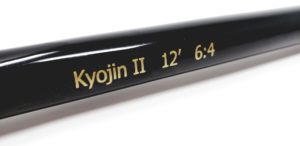 I missed a few hook sets initially because those saltwater babies come up so fast from the depths, out of nowhere, sometimes you’re not even sure what happened. Other times they would follow fast, then stop suddenly and disappear, the infamous high-speed refusal. But all-in-all the set-up was working fine and by using a two-handed spey and roll cast technique, I was able to get my line exactly where it needed to go and was able to work the fly just fine. The most exciting part of this scenario was the vantage point. From up high on a cliff, you could watch your fly move through the water and although everything in saltwater seems to happen at hyper-speed, you could see the fish – big fish, suddenly appear and chase in frenzies, then either take or refuse the hook. That alone was a blast. The trickiest part was standing on those sharp uneven rocks in wading boots.
I missed a few hook sets initially because those saltwater babies come up so fast from the depths, out of nowhere, sometimes you’re not even sure what happened. Other times they would follow fast, then stop suddenly and disappear, the infamous high-speed refusal. But all-in-all the set-up was working fine and by using a two-handed spey and roll cast technique, I was able to get my line exactly where it needed to go and was able to work the fly just fine. The most exciting part of this scenario was the vantage point. From up high on a cliff, you could watch your fly move through the water and although everything in saltwater seems to happen at hyper-speed, you could see the fish – big fish, suddenly appear and chase in frenzies, then either take or refuse the hook. That alone was a blast. The trickiest part was standing on those sharp uneven rocks in wading boots.
It took me a while to get my footing, feel at ease and be comfortable on my small ledge. I moved to a different location a few times but had to remember to stand back and wait for a wave to break first, in order to assess whether it was safe, or if I’d be knocked off my feet and swept into the water. We landed a few ladyfish, leatherjacks and jack crevalle, and then a big strike. I connected with what I initially thought was a permit but ended up being a big jack with a body the size of a turkey platter. It felt like I had hooked into a bullet train and I watched as the fish laid over on its side, at a 45-degree angle and flew through the water almost across the surface. I screamed…like a primordial, down-through-your-toes, straight from your gut, king-of-the-jungle, sort of scream. Actually, it was probably more of a bellow. At that moment, I think I channeled the Howler monkeys, and I held fast. Everything was fine. I took a millisecond to check my rod. The curve was on, deep and was a bend of perfection. The long handle provided me with the leverage I needed to steer and bring him around, this baby was getting landed. I surveyed the ground to get into my landing position, another millisecond and I found my path. Then, as suddenly and ferociously as it hit, the jack was gone. Off.
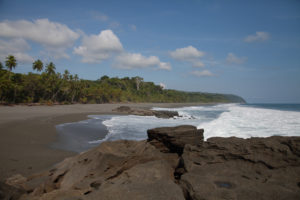
A second primordial bellow came out, but this time from the heart. The jack threw the hook and I was left there, on the cliff, heart pounding, adrenaline surging with a loose line being tossed around by the waves. Double hook set, double hook set, double hook set! That was a hard lesson learned well. I am still mourning that fish. It was beautiful. Those moments, that direct connection with the tenkara rod, the power and might, will play over, and over, and over again in my head and each time I’ll relive it and mourn once more.
The tide was rising and our way off the rocks was quickly disappearing. We broke down rods and started heading back to shore. I looked around one last time. We headed back to San José in the morning. What a country. What variety. I’m already missing Costa Rica. Release Fly Travel had shown me a spectacular week. We covered different regions and they each offered up a smorgasbord of incredible fisheries – different environments, different species and different experiences. All this excitement and there were still tarpon and sailfish available to me. For the angler and fly fisherman, this country offers something uniquely special. For the tenkara angler it is pure heaven on earth. For outdoor enthusiasts that want to taste everything, this is surely the place and Release Fly Travel is surely your outfitter.
 Costa Rica and Tom, thank you. I will forever hold this place dear – crocodiles, monkeys, iguanas, machaca, snook, guapote, Tico trout and that jack. All have touched my soul and opened up a new world of fishing for me. That is Costa Rica and thank you to Release Fly Travel, for an unbelievably fantastic experience and for their enthusiasm and passion for their county, for fishing and for tenkara.
Costa Rica and Tom, thank you. I will forever hold this place dear – crocodiles, monkeys, iguanas, machaca, snook, guapote, Tico trout and that jack. All have touched my soul and opened up a new world of fishing for me. That is Costa Rica and thank you to Release Fly Travel, for an unbelievably fantastic experience and for their enthusiasm and passion for their county, for fishing and for tenkara.




Great article. I want to travel to costa rica early 2022.
Its a great country with hugely diverse fishing opportunities. Tom Ederlin is your man whether you want to target trout or have a saltwater adventure – he does it all and will tailor it to your wants and needs. Glad you enjoyed the article.